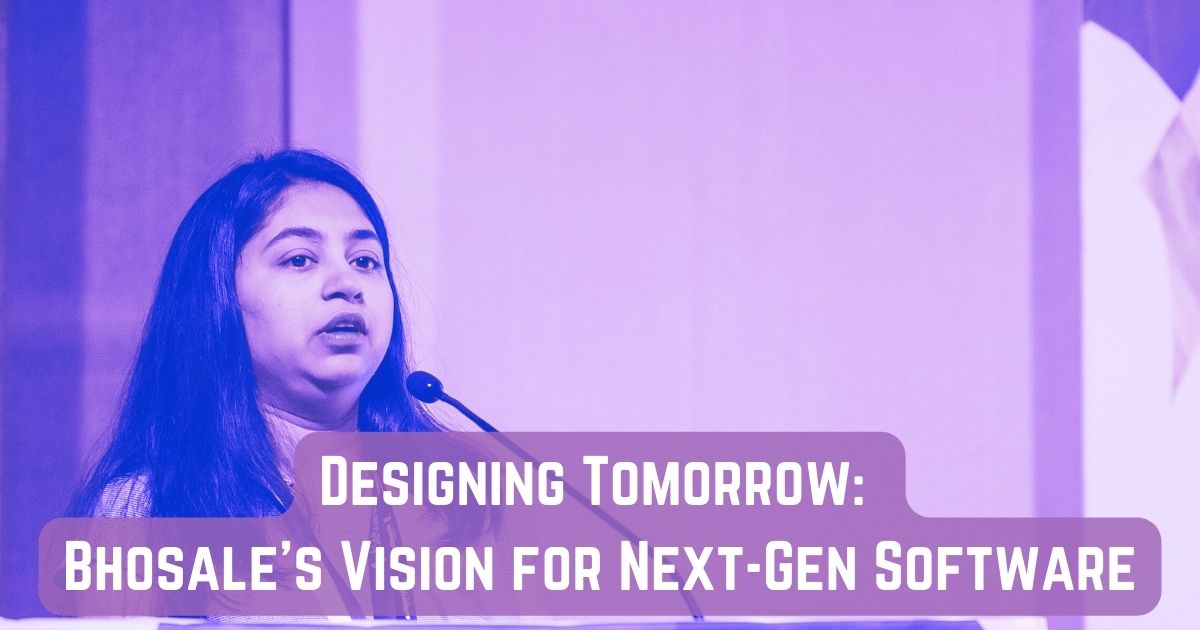
“Once again Saltmarch has knocked it out of the park with interesting speakers, engaging content and challenging ideas. No jetlag fog at all, which counts for how interesting the whole thing was."
Cybersecurity Lead, PwC

Mastering architectural patterns is not just an advantage; it's a necessity. At the recent Great International Developer Summit, expert Pallavi Bhosale took the stage to unravel the complexities of software architecture. Her session was more than a lecture; it was a deep dive into how architectural best practices can drastically uplift the quality of application development.
The journey begins with the monolithic architecture model, a foundational approach for many developers, handling everything from client-side presentation to logic and data management. However, as Bhosale points out, its limitations, particularly in scaling, are significant. Recent developments in the tech world, such as the scalability debates triggered by the surge in Ethereum and Bitcoin transaction fees, underscore the inefficiencies of monolithic systems. These challenges are mirrored in traditional software architectures, where scaling demands can lead to performance and management issues. A recent article on DevOps.com discusses the potential for a "Monolithic Renaissance," suggesting scenarios where monolithic architectures might be more suitable, highlighting the ongoing evolution in architectural choices. This evolving landscape underscores the need for adaptable and scalable approaches in software architecture, moving beyond the one-size-fits-all model.
As we transition from the limitations of monolithic architectures, the era of microservices architecture emerges as a pivotal paradigm shift, addressing scalability woes. Bhosale elucidates this concept, focusing on small, independent services, each adept in its domain, with the model's primary advantage being its scalability—each microservice can be scaled independently. However, challenges such as code replication persist, for which Bhosale suggests solutions like shared libraries and diverse communication protocols. Recent developments, like those highlighted in a Global Finance Magazine report, showcase the application of microservices in complex sectors like banking, emphasizing their adaptability and efficiency. The importance of design patterns in microservices, essential for enabling flexibility and preventing the impact on the entire application, is also increasingly recognized in the tech community. These insights reflect the ongoing evolution of microservices architecture, underscoring its potential in building adaptable, scalable, and efficient systems amidst the challenges of modern software development.
Building on the insights into microservices architecture, the conversation shifts towards hybrid microservices architecture, a balanced approach where parts of the application remain monolithic while others transition into microservices. Bhosale's emphasis is clear: architecture is not one-size-fits-all; it must be tailored to the specific needs of the project. This approach is gaining traction in the evolving landscape of software development, as seen in the rise of Event-Driven Architecture (EDA) in hybrid systems, highlighting its growing popularity among enterprises for its flexibility and efficiency in microservices environments. Moreover, the implementation of hybrid architectures in cutting-edge technology solutions, like IBM's new cloud-native QRadar SIEM, designed for hybrid cloud challenges and built with containers and microservices, showcases their increasing recognition as a versatile and effective solution. These developments underscore the capability of hybrid microservices architecture to bridge the gap between traditional monolithic structures and the dynamic microservices approach.
Following the exploration of hybrid microservices architecture, Bhosale's narrative seamlessly transitions to the innovative realm of front-end development, introducing the concept of micro front-end architecture. This approach, as she elaborates, empowers development teams to operate independently on various segments of a larger application, with each segment functioning akin to a mini-app within a broader ecosystem. The benefits of this approach are substantial, offering flexibility in technology choices and facilitating quicker integration of new features, ultimately leading to more dynamic and adaptive applications.
This shift towards micro front-end architecture is a testament to the industry's ongoing quest for more efficient and scalable solutions, as highlighted in Bhosale's insights. Recent advancements in this field, such as the evolution of micro front-end architecture, emphasize its potential in simplifying the development of complex applications by dividing them into smaller, more manageable components. This not only boosts scalability and maintainability but also promotes a more agile development process. Moreover, the practical application of micro front-ends in sophisticated, multi-cloud environments, as discussed in an article on the agile shift in composable technology, demonstrates how this architecture aligns with Bhosale's vision of a more efficient, flexible, and user-centric approach in software development. These developments underscore the growing relevance of micro front-end architecture, resonating with Bhosale's emphasis on adopting architectural strategies that best fit the unique requirements of each project.
Continuing from the discussion on micro front-end architecture, Bhosale delves deeper into the nuances of front-end architectural patterns like MVC (Model-View-Controller), MVP (Model-View-Presenter), and MVVM (Model-View-ViewModel). Using Angular as a case study, she illustrates the evolution of these patterns, emphasizing their role in enhancing data binding and interaction between the model and view, making them more efficient and streamlined.
This exploration into architectural patterns reflects a broader trend in software development, focusing on optimizing component relationships within applications. The distinctions and use cases for MVC, MVP, and MVVM are essential for developers to understand how each pattern can be leveraged for different project types. Furthermore, the versatility of these patterns across various platforms is demonstrated in their application in Android architecture, highlighting their adaptability. Bhosale's insights into these architectural patterns, aligned with these developments, underscore the importance of selecting the appropriate pattern to enhance application efficiency, maintainability, and user experience.
Bhosale doesn't stop at architecture; she dives into the nuances of structuring front-end code. She advocates for a modular approach—segmenting shared libraries, core functionalities, and features, thus bolstering maintainability and scalability. This structured approach goes hand in hand with a critical element of modern web design: accessibility.
Building on her insights into architectural patterns, Bhosale extends her expertise to the structuring of front-end code. She champions a modular approach, advocating for the segmentation of shared libraries, core functionalities, and features. This methodology not only enhances maintainability and scalability but also aligns perfectly with a critical element of modern web design: accessibility.
The modular approach in front-end development is increasingly recognized for its ability to streamline complex projects. A detailed exploration of this concept is evident in the discussion about Angular's latest release, which emphasizes the framework's modular capabilities. Furthermore, the importance of accessibility in web design, a key aspect of modern development, is illustrated in discussions about the agile shift in composable technology, showing how modular structures can enhance user experience. Bhosale's emphasis on a modular approach, coupled with these developments, underscores the significance of adopting flexible and accessible design principles in front-end development, ensuring that applications are not only efficient and scalable but also inclusive and user-friendly.
This emphasis on accessibility aligns with recent trends in web design, where inclusivity is not just a feature but a fundamental aspect. For instance, Applause's blog highlights the latest version of WCAG 2.2, released in October 2023, which sets new standards for web accessibility. Additionally, the role of accessibility in creating a disability-inclusive digital environment is explored in McKinsey's insights, emphasizing the need for accessible design in digital products and services. Bhosale's advocacy for inclusive design resonates with these developments, reinforcing the idea that accessibility is a crucial component of modern web design, essential for creating equitable and user-friendly digital experiences.
Continuing from her focus on accessibility and inclusive design, Bhosale wraps up her session by reiterating the importance of aligning software design with web accessibility standards and effective branding. She asserts that software design should reflect a brand's image and values, a principle that resonates deeply with developers and designers aiming to create impactful, user-centric applications.
This alignment of software design with branding and accessibility is a growing trend in the industry. For instance, Visme, a design software, offers a selection of templates that cater to branding and marketing needs without necessitating extensive design knowledge. This approach demonstrates how design and branding can be seamlessly integrated. Moreover, the role of software in enhancing employee engagement, as highlighted by U.S. News, further emphasizes the need for software to embody the ethos of a brand. Bhosale's emphasis on this integration of design, branding, and accessibility reflects a holistic approach to software development, ensuring that applications are not only functional and accessible but also resonate with the brand's identity and values.
In conclusion, Bhosale's session at the Great International Developer Summit was a comprehensive exploration of the latest trends in software architecture and inclusive design. Her expertise not only sheds light on the path for developers but also equips them with practical wisdom to tailor solutions that meet specific project needs, ensuring the sustainability and success of their software endeavors.
Watch the full video of the talk, here.
Questions or comments? Interested to contributing an article? Reach out to us here.
Banner Image Credits: Pallavi Bhosale at Great International Developer Summit

“Once again Saltmarch has knocked it out of the park with interesting speakers, engaging content and challenging ideas. No jetlag fog at all, which counts for how interesting the whole thing was."
Cybersecurity Lead, PwC

“Very much looking forward to next year. I will be keeping my eye out for the date so I can make sure I lock it in my calendar."
Software Engineering Specialist, Intuit

“Best conference I have ever been to with lots of insights and information on next generation technologies and those that are the need of the hour."
Software Architect, GroupOn

“Happy to meet everyone who came from near and far. Glad to know you've discovered some great lessons here, and glad you joined us for all the discoveries great and small."
Web Architect & Principal Engineer, Scott Davis

“Wonderful set of conferences, well organized, fantastic speakers, and an amazingly interactive set of audience. Thanks for having me at the events!"
Founder of Agile Developer Inc., Dr. Venkat Subramaniam

“What a buzz! The events have been instrumental in bringing the whole software community together. There has been something for everyone from developers to architects to business to vendors. Thanks everyone!"
Voltaire Yap, Global Events Manager, Oracle Corp.